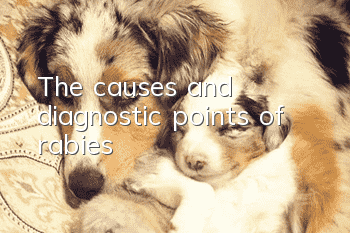The causes and diagnostic points of rabies

Causes of rabies:
1. Rabies virus mainly exists in the brain tissue and spinal cord of sick dogs. There are also large amounts of viruses in the salivary glands and saliva of sick dogs, and they are excreted out of the body with the saliva.
2. From 10 to 15 days before the clinical symptoms of sick dogs appear, to 6 to 7 months after the symptoms disappear, the virus can be contained in the saliva. Therefore, when the animal is bitten by a sick animal, Infection can occur.
3. Some healthy-looking dogs and cats can also contain viruses in their saliva. When they lick people or other animals, or live with people, they can also infect people.
4. Many wild animals, such as wolves, foxes, deer, bats, etc., can not only become ill and die after being infected with this disease, but can also expand the spread. For example, some species of bats (African vampire bats) often attack humans and animals after being infected with rabies virus, causing them to become infected.
5. Air contaminated by respiratory secretions and urine can also cause respiratory infections in humans and animals. Wild animals can become infected through their digestive tract by eating diseased carcasses.
Diagnostic points of rabies:
The disease usually occurs in sporadic form, that is, there are many single cases, and most of them have a history of being bitten by a rabid animal. Generally, there are more cases in spring and summer, which is related to the sexual activities of dogs. The clinical characteristics of rabies are as follows:
1. At the beginning of the disease, the main manifestations are depression and abnormal behavior, such as not listening to calls, liking to hide in dark places, having strange habits, and liking to eat gravel, wood, soil, etc. , sick dogs often lick the bite wounds with their tongues.
2. Later, it develops into violent and restless behavior, attacking people and animals, and often running around aimlessly. Appearance: The sick dog gradually loses weight, the mandible droops, and the tail droops and is sandwiched between the two hind limbs. Hoarseness, increased salivation, and difficulty swallowing.
3. In the later stage, the sick dog will develop symptoms of paralysis, difficulty walking, and eventually systemic failure.
- Things to note when raising a Samoyed dog
- What should I do if my German Longhaired Pointer vomits after eating too much?
- What's wrong with a dog that vomited in the middle of the night after eating a bone?
- What’s the best way to deworm your dog?
- How is canine distemper parvovirus transmitted?
- Four training methods for Hebei fine dogs
- How to train a golden retriever to sit still
- What should I do if my Chihuahua likes to bark?
- Can canine distemper be transmitted to humans? How to treat canine distemper?
- What should I do if my Labrador is too fat?



